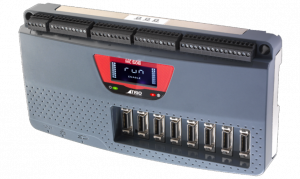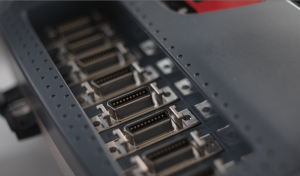The MC508 is a high specification Motion Coordinator using a high performance ARM Cortex A9 800 Mhz Processor, with eight Voltage outputs and eight flexible axis ports, that can be configured for up to sixteen pulse and direction output axes or eight closed loop servo axes. It boasts 128 MBytes of RAM; 32 of which is for user programs and user table space.
The flexible axis MDR type connectors allow single cable connection from the MC508 to your drive. The port can be configured in software as feedback devices or pulse direction outputs. As outputs they can be used as pulse and direction with stepper or servo drives or they can operate as a simulated encoder output. When configured as feedback they can be either incremental encoder input or one of four popular absolute encoder types; SSI, BiSS, Tamagawa or Endat. All feedback axes can be used to form a closed loop servo with a voltage output.
The MDR 3m cable may be purchased seperately (P382).
Highlights
- Advanced 8 Axis Closed Loop Servo / 16 Axis Pulse Direction
- Total of 32 Digital Inputs and 16 Digital Outputs
- EnDAT, Biss and SSI Absolute Encoder Supported
- Linear, Circular, Helical and Spherical Interpolation
- Flexible CAM shapes, Linked Motion
- Hardware Linked Outputs for Camera / Laser Control
- Ethernet-IP / Modbus TCP / Ethernet Interface Built-In
- IEC 61131-3 Programming
- Multi-tasking BASIC Programming
- Text File Handling
- Robotic Transformations
- SD Memory Card Slot
- CANopen I/O Expansion
- Backlit LCD Display
- RoHS and CE Approved
The built-in Ethernet port allows programming and connection of common HMI and PLC protocols directly to the MC508. User programs can be written in Trio’s established multi-tasking TrioBASIC language using the powerful MotionPerfect v4 application development software making complex motion easy. Also available are the industry standard IEC 61131-3 languages allowing a fully functional PLC programming system.
Options
The MC508 is available in 2 different axis configurations. Both models feature a total of 32 axes in software. Any axes not assigned to built-in hardware can be used as a virtual axis. Every axis can be programmed to move using linear, circular, helical or spherical interpolation, electronic cams, linked axes and gearboxes.


